Birds of prey are those birds that hunt and eat invertebrates, including other birds. They are generally large, powerful flyers with excellent eyesight (owls, who hunt at night, also have excellent hearing) talons on their feet and hooked beaks. Their other name is raptor, which comes from a Latin word that means to “seize by force” which is what they do. Here are some birds of prey that patrol US skies.
Eagles

A sharp, curved beak and razor sharp talons make the bald eagle a formidable hunter.
©PHOTOOBJECT/Shutterstock.com
There are 68 species of these large, powerful birds of prey, but only two live in the United States. “Eagle” isn’t really a scientific term but is used for a bird large and strong enough to hunt vertebrates that are at least 1.6 feet in length. The two eagles found in the U.S. are:
Bald Eagle
Of course, this eagle, Haliaeetus leucocephalus is the United States’ national bird. Of course, this magnificent bird isn’t bald at all, but the feathers of its head and neck are white. The rest of the body, save the white tail and rump, is dark grayish brown.
The bald eagle is found all over North America and likes to roost and nest near large bodies of water. Adult birds are 31 to 37 inches long and have a wingspan of between 5.8 and 7.9 feet. For all that, the average weight is about 9.5 pounds. Their bills, heads, and feet are large in proportion to the rest of their bodies, and their talons are formidable.
When it comes to predation, the bald eagle has a varied diet, but it prefers fish, including salmon, Pacific cod, catfish, eels, shad, and trout. They’ll also take waterbirds such as geese and small mammals such as voles and squirrels. The bald eagle isn’t above eating carrion or garbage found in landfills, and it will steal the catch of other birds of prey.
Eagles live between 15 and 20 years and live longer in captivity. At least one wild eagle lived to be 28, while a captive eagle lived to be 47. Though the bald eagle was once endangered, its conservation status is now least concern.
Golden Eagle
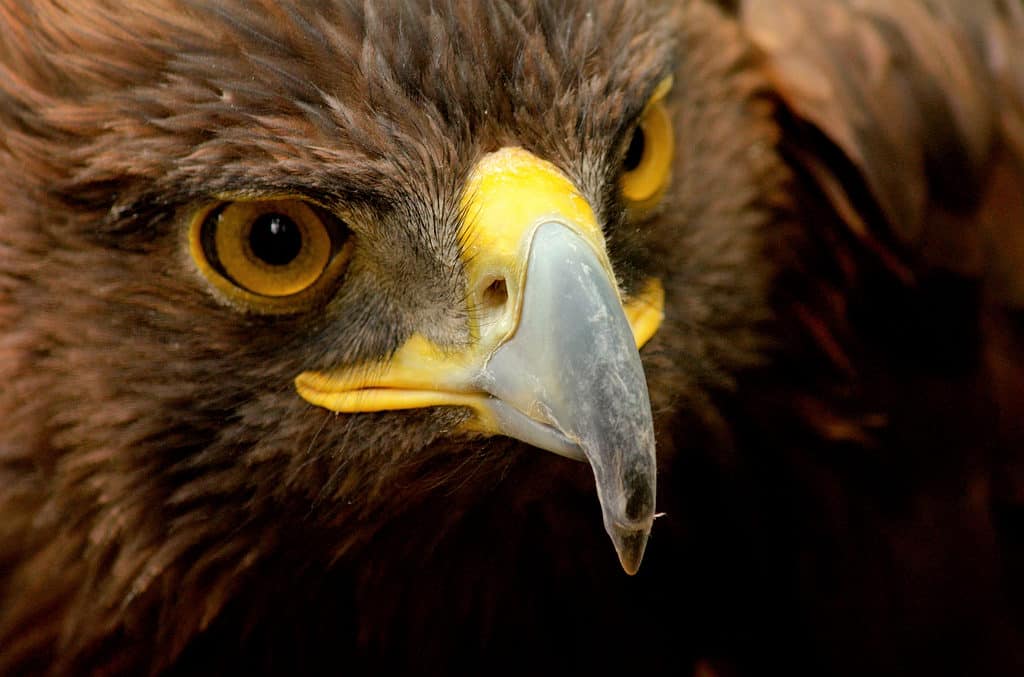
The golden eagle belongs to the
Aquilagenus.
©iStock.com/Paco Adame
The golden eagle, Aquila chrysaetos not only patrols the skies of the United States, but Eurasia and northern Africa. In North America, you’ll find most of them out west, from Alaska to Mexico in shrublands, grasslands, coniferous forests, mountains, and open places.
This bird is from 27.56 to 33 inches long with a wingspan of between 6 and 7.25 feet. It weighs between 6.6 to 13.5 pounds, and females are considerably bigger than males. They have dark brown plumage, though the tail is grayish-brown and there are golden feathers at the top of the crown and around the neck and the face. The bird’s legs are completely feathered, and unlike the yellow beak of the bald eagle, the golden eagle’s beak is black. The golden eagle has five subspecies, though only A. c. canadensis lives in North America.
Golden eagles’ diet is mostly small mammals like prairie dogs, ground squirrels, and rabbits. They’ll also eat other birds, fish, and reptiles, and will sometimes tackle larger animals such as seals, coyotes, or flying geese. They can do this because golden eagles often hunt in pairs. One eagle chases the prey until it’s exhausted then the other eagle kills it.
Golden eagles can live up to 48 years in the wild and their conservation status is least concern, though they’re protected under the U.S. Migratory Bird Act.
By the way, some biologists claim that a “true” eagle is one that belongs to the Aquila genus. In that case, the golden eagle is North America’s only “true” eagle.
Hawks
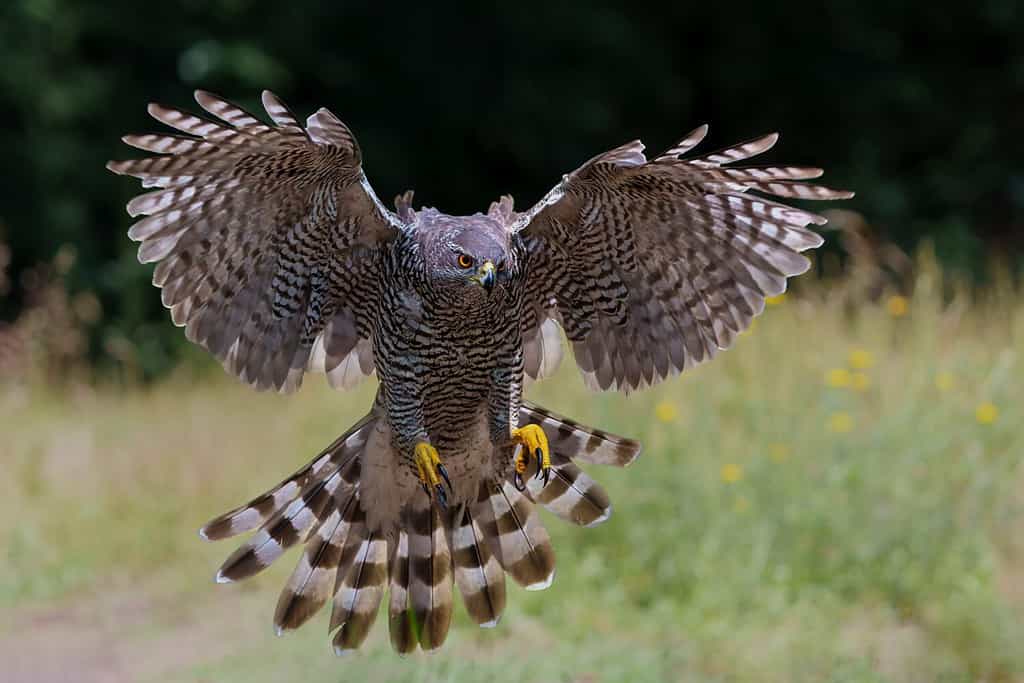
The goshawk is the largest bird in the
Accipitergenus.
©Henk Bogaard/Shutterstock.com
“True hawks” or Accipiters are members of the Accipitridae family. These birds tend to live in the woods, and have short but wide wings, excellent eyesight, and long tails they use as rudders. They’re largely ambush predators.
Northern Goshawk
This hawk, Accipiter gentilis lives in the deciduous and coniferous forests and mountains not just of the United States but of Canada, Mexico, and Eurasia. It is the largest bird in its genus and is 21 to 24 inches long with a 38.6 to 45 inch wingspan. It weighs between 1.39 and 3 pounds. Like other accipiters, this bird has white “eyebrows,” and its eyes are red or reddish brown in adults. The hawks’ upper feathers are dark, but their bellies are white with gray bars, and the gray tails have dark bands.
These hawks have a varied diet of other birds, small mammals, reptiles, and fairly large insects. They have no problem handling prey that weighs half their weight. Sometimes they’ll cache prey. In turn, goshawks, especially young ones, are preyed on by large owls, other hawks, eagles, and wolves. Goshawks live an average of 11 years, and their conservation status is least concern.
Other true hawks in the United States are:
- Cooper’s Hawk, A. cooperii
- Sharp-shinned Hawk, A. striatus
Vultures

Though considered birds of prey, vultures like this black vulture prefer carrion.
©Holly Guerrio/Shutterstock.com
Vultures are more often carrion eaters than they are hunters, but now and then they’ll take live prey. There are two types of vultures, and the ones that live in the U.S. are New World Vultures.
Black Vulture
Named for its naked black head and inky black feathers, Coragyps atratus lives all over the United States, southern Canada, and down to the southern parts of South America. This bird likes open areas where they have a good view of the terrain. Rhese would be fields, cities, towns, deserts, and places where people dump their refuse. It is a largish bird that’s 1.6 to 2.26 feet long with a 4.49 to 5-foot wingspan. The skin on their head and neck is black and wrinkled, the better for them to stick their heads into opened carcasses. Unlike other raptors, the vulture has weak feet that are not good for grasping prey.
Black vultures eat just about anything that’s edible. This includes road kill and the contents of sewers and garbage dumps. They’ll also eat eggs, fruits and vegetables, whether fresh or rotting, and baby animals. Once they find a source of food, they eat until they are stuffed.
Black vultures have lived as long as 21 years in captivity, and their conservation status is least concern.
Other vultures found in the United States are:
- Turkey Vulture, Cathartes aura
- California Condor, Gymnogyps californianus
Kestrels
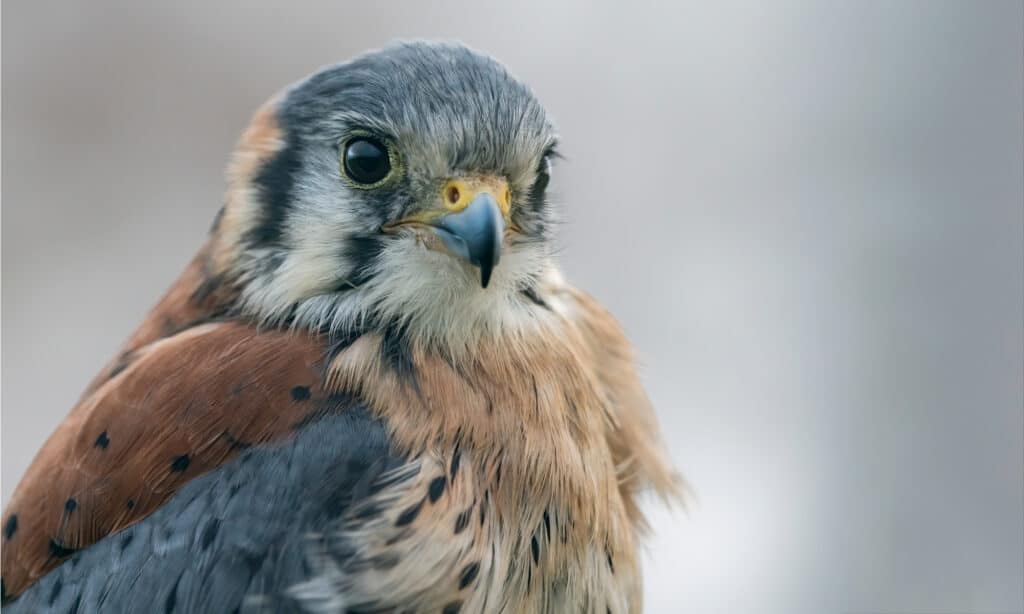
The American kestrel belongs to the same genus as the falcons.
©Albert Beukhof/Shutterstock.com
Kestrels and falcons belong to the same genus, but you can tell a kestrel from a falcon because they are smaller than their cousins. The kestrel found in the United States is the American Kestrel. Also called the sparrow hawk, this little bird of prey is a permanent resident in much of the United States. It breeds in the northern U.S. and up into Canada.
The American kestrel’s scientific name is Falco sparverius, and it has 17 subspecies. You’ll find them in forests and rainforests, deserts, grasslands, farms, mountains, and cities.
The diet of the American kestrel depends on the season. In summer they eat mostly insects, and during the winter they eat small mammals such as mice, reptiles, amphibians, and birds that are smaller than they are. They are not above taking pets and chickens. In turn, kestrels are preyed on by larger birds of prey, though these raptors usually eat the kestrel’s eggs or chicks.
These little birds are a bit different from some other raptors in that you can tell the sexes apart. Males have bluish-gray crowns, while the crowns and wings of females are reddish brown. Both of them have black and white feathers on their faces, including black bands. They have long, tapered wings and tails, and range in length from 8.66 to 12.20 inches, with a 20 to 24-inch wingspan. They only weigh 2.8 to 5.8 ounces. Kestrels live only about a year in the wild, though one was known to have lived for 11 years. Their conservation status is least concern.
Buzzards
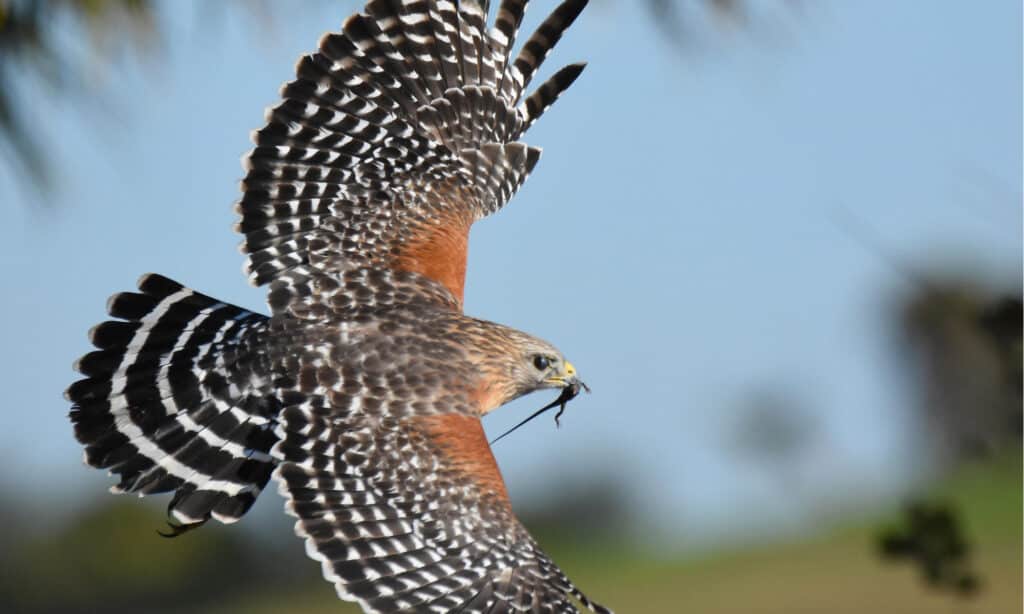
The red-shouldered hawk is a member of the
Buteogenus and thus a buzzard.
©MTKhaled mahmud/Shutterstock.com
“Buzzard” is the name Americans, especially those from the South, call vultures. But real buzzards belong to the Buteo genus. These raptors can be considered types of hawks. They include:
Red-shouldered Hawk
This hawk, Buteo lineatus is found in North America from southern Canada, through the United States, and down to northern Mexico. These hawks usually live in woods, forests, and swamps and build their nests in deciduous trees, especially if they’re near a few dead trees. These leafless trees allow the buzzard to perch and have a clear view of its surroundings.
Red-shouldered hawks are large birds that range from 1.4 to 2 feet long, with a wingspan of 3 to 3.5 feet. Heavy for birds of their size, they weigh between 1.21 and 1.54 pounds. They have brown heads, brown backs, and rufous underparts with brown streaks. Their tails are long for the body, brown, and banded with white. The bird’s “shoulders” are famously red. There are five subspecies of the red-shouldered hawk.
Diet, Lifespan, Other Buzzards
This buzzard eats small mammals such as rabbits, and they’ll also eat larger insects, smaller birds, reptiles, and amphibians. They’ll eat crayfish if they’re found in their area. The bird’s strong wings allow it to soar for a long time while it looks for prey on the ground. When they see a prey animal, they drop down on it and kill it. Though a powerful bird, the red-shoulder hawk is still prey for raccoons and great-horned owls when they’re on the nest.
Red-shouldered hawks are ready to breed when they’re about a year old, but in the wild most of these buzzards only live a little over two years. Yet, there was one that lived for nearly 20 years. The conservation status is least concern. Other United States buzzards are:
- Rough-Legged hawk, B. lagopus
- Ferruginous hawk, B. regalis
- Red-tailed hawk, B. jamaicensis
Harriers
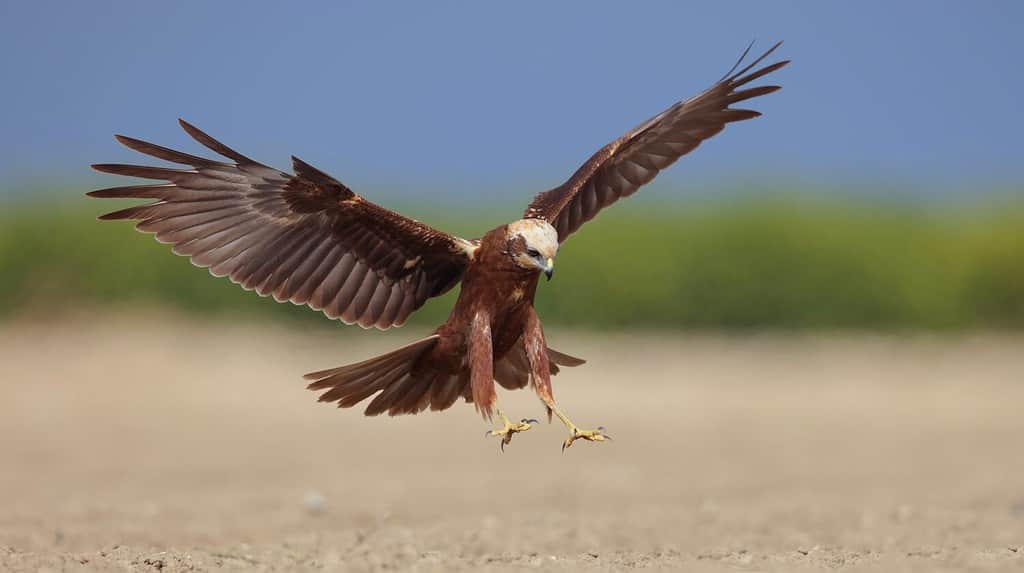
A harrier can be told from a hawk by its long legs.
©leventgoksoy/Shutterstock.com
Harriers can be told from proper hawks because they have notably longer legs. Aside from keen eyesight, they also have excellent hearing that helps them to hunt. To funnel sound to their ears, they’ve evolved a disc of feathers around their face, much like an owl. The one harrier found in the United States is the marsh hawk, Circus cyaneus. It’s a wide-ranging bird that lives in North America, Central America, and the Caribbean. It breeds in Eurasia, and overwinters in northern Africa and the Asian tropics. You’ll find it in open places such as savannas, fields, prairies, marshes, and meadows and on farms.
Marsh hawks have yellow eyes, and the males are gray on top and white beneath, though their chests have spots. Females are brown, with white stripes beneath their wings. Marsh hawks range between 16 to 19 inches long with a wingspan of 13.4 to 15 inches and weigh a little over 10 ounces to 1.32 pounds. The bird’s diet depends on where it lives. If there are a lot of little mammals in the area, they’ll take them. They also eat smaller birds, snakes, and frogs. They’ll sometimes cache their prey. A great number of animals eat marsh hawks as well, including owls, foxes, coyotes, and larger raptors who mostly eat the eggs and chicks. Marsh hawks live about 16 years in the wild, and their conservation status is least concern.
Kites

The Everglade or snail kite has red eyes.
©John P Ruggeri/Shutterstock.com
Kites are known for their ability to fly fast and soar. They belong to several genera and subfamilies in the Accipitridae family. Kites that fly in the skies over the United States include the Everglade Kite, Rostrhamus sociabilis. As its name suggests, this is a kite found in Florida, especially in the areas around the Panhandle and the Everglades. It’s also called the snail kite, and though its IUCN Red List status is least concern, it is endangered under the US Federal List thanks to habitat destruction.
The Everglade kite is between 14 and 16 inches long and weighs between 12 and 20 ounces. Their wingspan is between 36 and 43 inches, and unusually for raptors, males are a little bigger than females. Males are slaty gray and brown, and have orange legs. The female is also brown but her face, throat, and chest are streaked with white. Both sexes have ruby-red eyes and a dark, squared-off tail that’s white underneath.
This kite eats apple snails, which are found in fresh water. If the snails are scarce, the kite will eat turtles. The apple snail is small, and it takes some skill for the kite to target and actually grab one out of the water. Once it catches the snail, it eats by holding it in one foot and using its sharp, hooked bill to pull it out of the shell. The snail kite lives about 15 years in the wild. Other kites in America are:
- White-tailed kite, Elanus leucurus
- Mississippi Kite, Ictinia mississippiensis
Osprey

An osprey plunges after its prey feet first.
©Wang LiQiang/Shutterstock.com
The osprey, Pandion haliaetus is the only species in the Pandion genus, and the Pandion genus is the only genus in the Pandionidae family. What makes this amazing is that ospreys are found all over the world, and not just in the United States. The osprey lives almost exclusively on fish and is known for building large nests near bodies of water. Their eyes have actually evolved to see their prey underwater. When they see a fish, they hover a moment, plunge into the water and catch the fish in their talons. Sometimes the bird goes completely underwater to do this. If it’s submerged, the osprey is able to close its nostrils. Ospreys also have thick, oily feathers that at least partially repel water.
The osprey is a large bird that’s a little less than 2 feet long, with a wingspan between 4.75 to 5.58 feet. It has long wings with a distinctive bend in them. Their bellies are bright white, and they have a dark brown necklace, a brown back, dark stripes across their eyes, a black beak, and taloned feet that are blue-gray. The eyes of adults are yellow while those of juveniles are orange-red. Ospreys live a long time for birds of prey, and the oldest osprey known lived to be 25. Their conservation status is least concern.
Owls
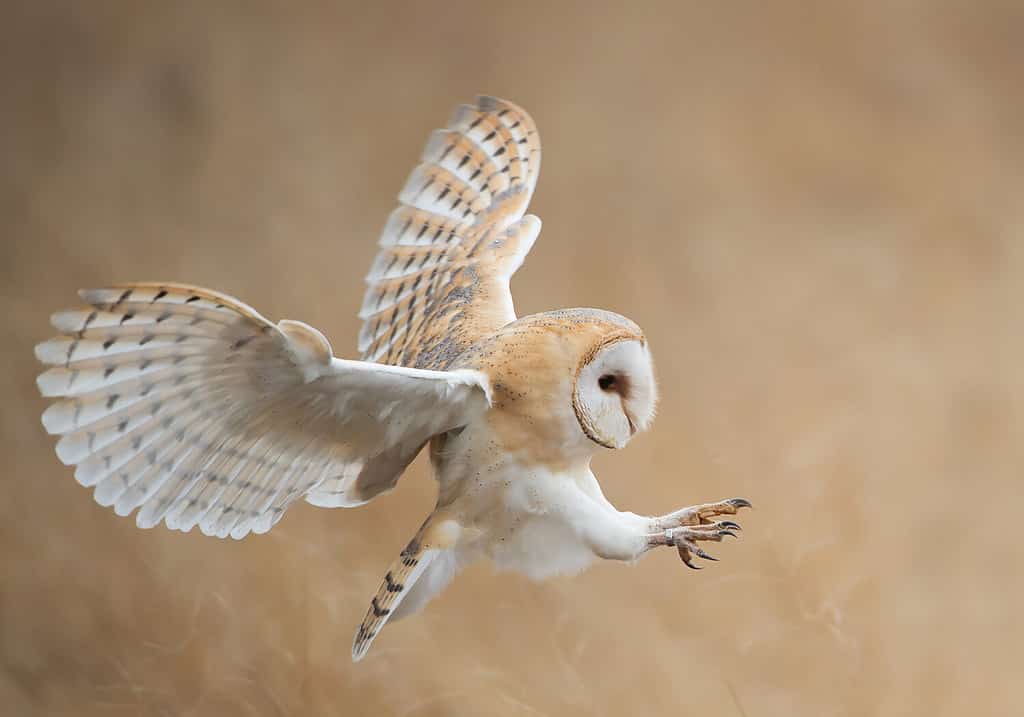
With its heart-shaped face and round wings, the
barn owl
looks like no other American owl.
©MZPHOTO.CZ/Shutterstock.com
Most owls famously hunt at night. For this reason, they have huge, forward-facing eyes, acute hearing, and feathers that are nearly soundless when they fly. There are several species of owl in the United States, including the barn owl, Tyto alba. This unusual-looking owl is not just found in the U.S. but everywhere on earth save Antarctica. Because it’s so widespread it’s adapted to a wide range of habitats, but it needs cavities to nest in. If there are no cavities, whether in trees, buildings, or cliffs, the barn owl may be hard to find.
Heart-shaped Head, Soft Feathers, Killer Talons
The barn owl is 12.6 to 15.75 inches long with a wing span of 3.51 to 3.6 feet, and it weighs between 15 and 22 ounces. The look of this owl distinguishes it from any other. Its head is large, and it has a heart-shaped face created by the two facial disks that surround its eyes. It has no ear tufts like some other owls, and its wings are round and its tail is short, and it has feathers down to its feet. The owl’s feathers are very soft, almost downy. Its dorsal side is tan and spotted with black and white, while the ventral side is grayish-white.
The barn owl’s acute hearing allows it to hunt in total darkness, and its feathers allow it to hunt in total silence. It flies low to the ground, grabs the prey with its talons, kills it with a bite through the back of the head, and swallows it whole. Prey includes small mammals and small birds that the owl starts to hunt after the sun sets. Great horned owls sometimes prey upon barn owls, even when they’re adults. Other raptors, snakes, and stoats eat chicks.
Most wild barn owls don’t live long and die before they’re two years old. However, one bird did live to be 34 years old. The owl’s conservation status is least concern. Other owls that patrol U.S. skies include:
- Great horned owl, Bubo virginianus
- Western screech owl, Otus kennicottii
- Eastern screech owl, Otus asio
- Barred owl, Strix varia
- Burrowing owl, Athene cunicularia
- Short-eared owl, Asio flammeus
Falcons
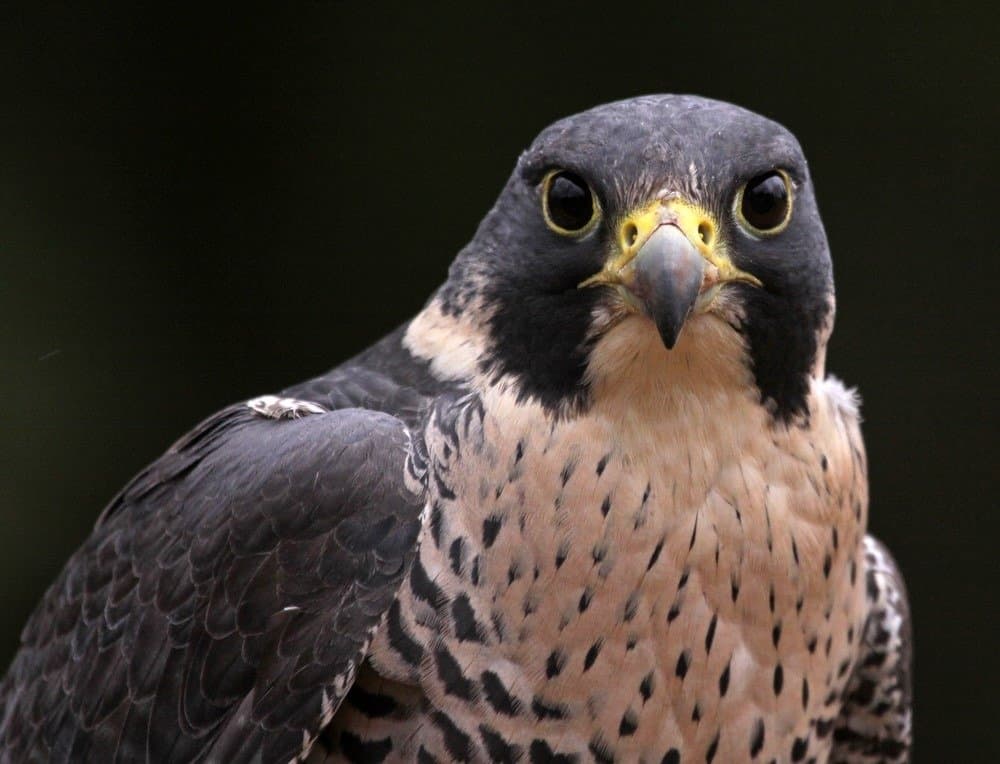
The
peregrine falcon
is not only the fastest of the birds of prey but the fastest animal in the world.
©Chris Hill/Shutterstock.com
These are medium-sized birds of prey known for their great speed. The fastest animal on earth, the peregrine falcon has been clocked at dives of over 200 miles per hour. The falcon’s wings are long and tapered, and their vision is amazingly sharp and allows them to spot prey at a distance. The peregrine falcon, Falco peregrinus is one of the most widespread falcons. It is not only found in the United States but all around the world save for the coldest regions.
About the Peregrine Falcon
The peregrine falcon usually lives in open habitats where it can get a good view of prey. They have come to build nests on buildings and bridges in cities for the same reason and for the abundance of city birds such as pigeons, starlings, and sparrows. There are 19 subspecies of the peregrine falcon, but they all have long wings that come to a point and a short tail. They range in length from 14.17 to 23 inches and have a wingspan of 3 to 3.67 feet. Their wings are slaty blue, their bellies are pale and their backs have black bars. They also have black stripes on their faces and huge, forward-looking eyes.
When it comes to food, peregrine falcons specialize in other birds. Of birds, they prefer doves and pigeons. They’ll also take smaller mammals such as bats, which they may eat on the wing. The falcons also eat rodents as well as reptiles and may go to ground to search for them. Most peregrine falcons don’t live long, but those that do can live to be about 13. The famous Pale Male, who lived around New York’s Central Park, lived to be at least 32. The peregrine falcon’s conservation status is least concern.
Other U.S. falcons are:
- Merlin, F. columbarius
- Prairie Falcon, F. mexicanus
Honorable Mention: Shrike
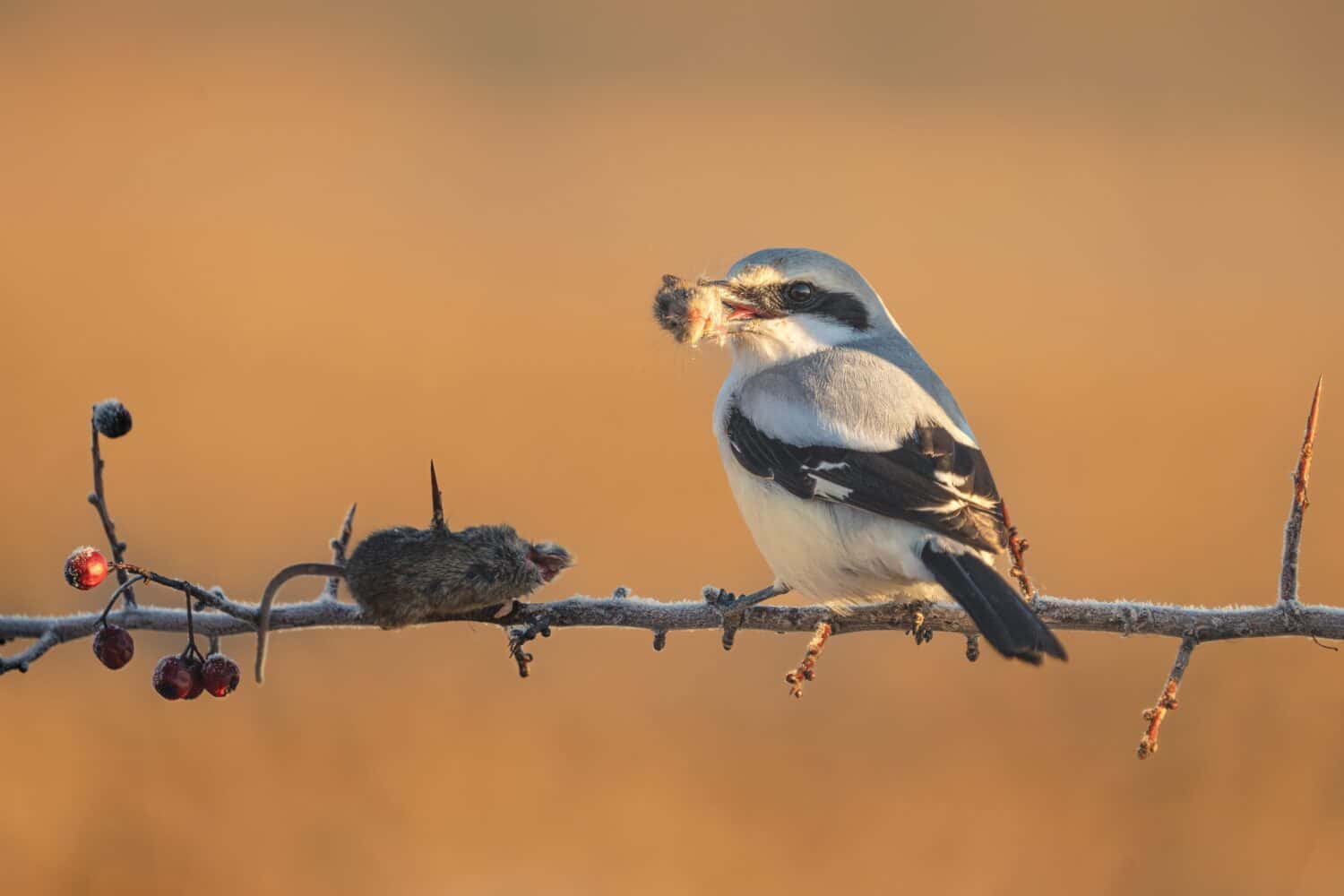
Since a shrike lacks the talons of other birds of prey, it impales its victims and eats them at leisure.
©Dronenation/Shutterstock.com
The shrike, a member of the Lanius genus, is a small bird that lacks the talons of the bigger birds of prey. Yet, it frequently takes vertebrates that are quite large in proportion to itself. These include mice and voles. Since it can’t grapple the prey with talons, the shrike impales it on a thorn, twig, or even on barbed wire. This both kills the prey if it’s not already dead (the shrike sometimes bashes its prey to death first) and holds it in place so the bird can easily eat it.
Fun Fact
With most raptors, females are larger than males.
The photo featured at the top of this post is © ranchorunner/Shutterstock.com
Thank you for reading! Have some feedback for us? Contact the AZ Animals editorial team.






